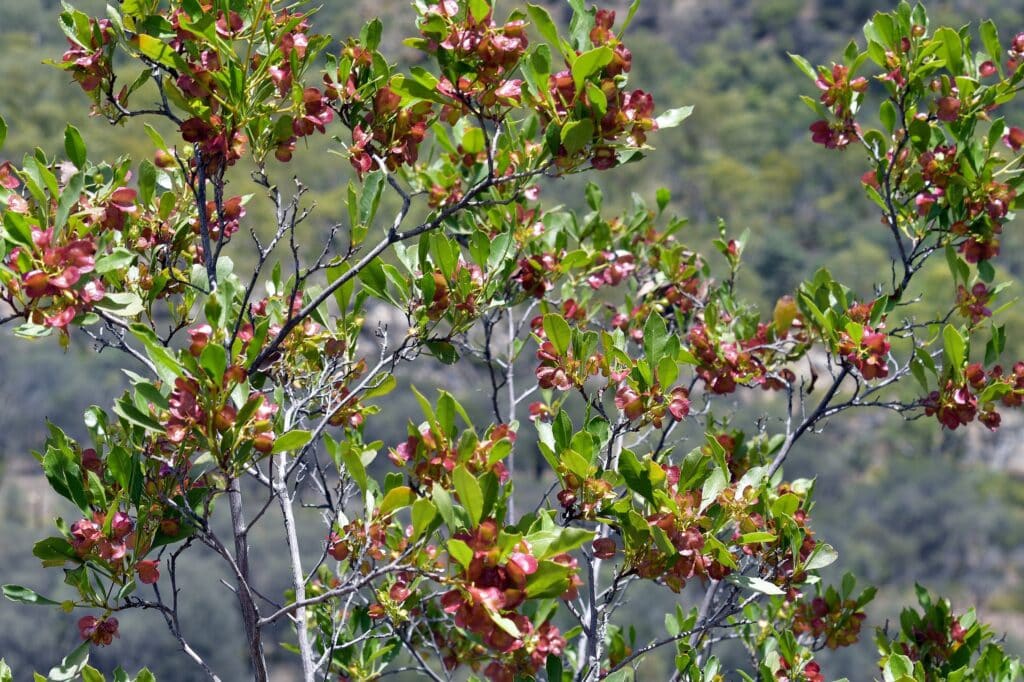Aalii (Dodonaea viscosa) is a versatile native shrub found throughout the Hawaiian Islands. Known for its hardiness, Aalii (Dodonaea viscosa) grows in coastal dunes, dry forests, and high mountain slopes. This resilient plant tolerates wind, drought, and poor soil, making it ideal for Hawaiian landscapes. It serves important ecological and cultural roles in traditional Hawaiian life and modern conservation efforts.
The name “Aalii” comes from the Hawaiian language, reflecting its deep-rooted place in local history and tradition. Early Hawaiians used its dense wood for tools and house construction, showcasing its practical value. Its reddish seed capsules also provided natural dye, contributing to the art of kapa making. Today, Aalii (Dodonaea viscosa) continues to support habitat restoration and erosion control across the islands.
This plant’s adaptability makes it a standout choice for home gardens, public spaces, and reforestation projects. Its compact growth and colorful seed pods add aesthetic value while supporting biodiversity. With minimal care requirements, Aalii (Dodonaea viscosa) offers a low-maintenance, high-reward option for Hawaiian gardeners. Learning more about Aalii helps foster appreciation for native plants and promotes sustainable landscaping practices.
Aalii (Dodonaea viscosa) deserves recognition for its beauty, resilience, and contribution to Hawaii’s environment and heritage.
Aalii – Dodonaea viscosa Details
Aalii (Dodonaea viscosa) is an evergreen shrub or small tree native to tropical and subtropical regions, including Hawaii. It typically reaches heights between three and twenty feet, depending on local conditions and care. Its narrow, leathery leaves are bright green and slightly sticky, giving the species its Latin name “viscosa.” Over time, the plant forms a dense, rounded shape with attractive reddish seed capsules.
The seed capsules appear in fall and winter, offering visual interest with their winged, papery texture and deep pink to red color. These capsules attract native insects and birds, adding life and color to any garden or natural setting. Aalii (Dodonaea viscosa) is dioecious, meaning individual plants produce either male or female flowers. Both types are small and greenish, often overlooked but essential for reproduction.
In Hawaii, Aalii adapts well to a range of elevations, from sea level up to 7,500 feet. Its ability to thrive in dry, rocky, and windy environments makes it essential in native reforestation and erosion control projects. The plant also resists pests and diseases, requiring little intervention once established. Aalii (Dodonaea viscosa) stands out as both a beautiful and functional part of Hawaiian flora.
Varieties and Cultivars
Aalii (Dodonaea viscosa) grows in many forms across Hawaii, adapting to diverse conditions from Kaua‘i to the Big Island. On O‘ahu, it’s seen thriving near Diamond Head and Ka‘ena Point, with upright growth and narrow, leathery leaves. Maui’s dry slopes, like Auwahi near Haleakalā, host bushier forms with slightly broader foliage. These natural variations help the plant survive across different elevations and soil types.
While Hawaiian forms are native, other regions like Australia have developed ornamental cultivars for color and structure. One well-known variety, ‘Purpurea,’ displays striking purple foliage and is often used in mainland U.S. landscapes. These cultivars still retain the toughness of Aalii (Dodonaea viscosa) but are tailored for garden aesthetics. Hawaiian conservation projects, however, prefer native genotypes to preserve ecological integrity.
Hawaiian nurseries may offer local ecotypes suited to specific islands or elevations. Selecting plants from your island, whether O‘ahu, Maui, or Hawai‘i, supports genetic diversity and better plant performance. For landscaping purposes, purple-leaved or compact cultivars can be used sparingly without affecting wild populations. Native varieties should always be chosen for reforestation and habitat restoration efforts.
Aalii (Dodonaea viscosa) provides variety in form and color, offering flexibility for both gardeners and conservationists across the Hawaiian Islands.
Best Time to Plant
In Hawaii, the best time to plant Aalii (Dodonaea viscosa) is during the wetter months between November and April. This season provides consistent rainfall, which helps young plants establish strong roots without the need for constant watering. The milder temperatures also reduce stress on seedlings during transplanting. Choosing the right time supports healthy growth and long-term success.
Although Aalii (Dodonaea viscosa) is drought-tolerant, planting during the rainy season gives it a solid head start. Early establishment allows the plant to better withstand dry summers on islands like O‘ahu and Hawai‘i. Landscapers and conservation groups often schedule planting projects during winter for maximum impact. This timing aligns with natural growth cycles and minimizes maintenance needs.
You can plant Aalii at other times of year, but more care is required to keep it hydrated. In dry months, supplemental watering may be necessary until roots are well developed. It’s best to avoid planting during extreme heat, especially in exposed or windy areas. Early planning ensures that your Aalii adapts quickly and begins thriving.
For successful establishment, align planting time with nature’s rhythm, giving your Aalii (Dodonaea viscosa) the best possible start in its new environment.
Growing Conditions
Aalii (Dodonaea viscosa) thrives in a wide range of conditions, making it ideal for many parts of Hawaii. It grows well in full sun, tolerating wind, salt spray, and drought, especially in areas like Ka‘ena Point or Pu‘u Wa‘awa‘a. The plant prefers well-drained soil but adapts to rocky or sandy areas with little organic matter. Once established, it needs minimal water and care.
This hardy native does best in elevations from sea level to 7,500 feet, covering coastal dunes, dry slopes, and upland forests. On Maui’s dry leeward side or O‘ahu’s ridgelines, Aalii (Dodonaea viscosa) can be found growing naturally without irrigation. These areas mimic ideal conditions, plenty of sunlight, little shade, and infrequent but deep watering. Avoid overly wet or poorly draining soils to prevent root problems.
Although adaptable, it struggles in consistently wet or shaded environments where fungal issues can develop. If planting near other trees or in wetter zones, choose elevated spots with good airflow. With the right placement, this plant resists pests and thrives year-round. Always assess local microclimates when choosing a planting site.
Aalii (Dodonaea viscosa) rewards gardeners with resilience and beauty when given the right growing conditions native to the Hawaiian Islands.
Planting Instructions
To plant Aalii (Dodonaea viscosa), choose a sunny, open location with well-draining soil and minimal shade. Begin by digging a hole twice the width of the plant’s root ball and equally deep. Carefully remove the plant from its container, loosening any circling roots before placement. Position it in the hole so the base sits level with the ground.
Backfill with native soil, gently pressing down to remove air pockets without compacting the area too much. Water thoroughly after planting to help settle the soil and reduce transplant shock. If planting during the dry season, continue watering every few days until roots establish. In wetter months, rainfall may provide enough moisture for young plants.
Spacing depends on use, three to six feet apart works well for hedges or natural groupings. Mulch lightly around the base to retain moisture and suppress weeds, keeping mulch a few inches from the stem. Avoid fertilizers during the early stages, as Aalii (Dodonaea viscosa) adapts well to nutrient-poor soils. Focus on good placement and proper watering instead.
With thoughtful planting, Aalii (Dodonaea viscosa) establishes quickly and thrives with little effort, making it perfect for sustainable Hawaiian landscaping.
Care and Maintenance
Aalii (Dodonaea viscosa) requires little care once established, making it ideal for low-maintenance gardens throughout Hawaii. Water young plants regularly during the first few months, especially in dry or windy areas like Maui’s leeward coast. After establishment, reduce watering to occasional deep soaks during extended droughts. Overwatering can lead to root rot, so always let the soil dry out between waterings.
Prune lightly to maintain shape and encourage bushy growth, especially after flowering or seed capsule drop. Use clean tools to avoid spreading disease, although Aalii (Dodonaea viscosa) rarely faces pest or fungal issues. Remove any dead or broken branches to keep the plant healthy and attractive year-round. Periodic pruning also stimulates new growth and enhances the plant’s natural form.
Fertilization is generally unnecessary, especially in native or dryland settings, where the plant thrives in low-nutrient soil. If growth seems slow, add a light layer of compost during the wet season. Avoid chemical fertilizers that may disrupt soil health or surrounding native species. Healthy soil and proper placement typically meet all the plant’s nutritional needs.
With minimal effort, Aalii (Dodonaea viscosa) remains vibrant, contributing beauty and ecological value to Hawaiian gardens and restoration projects.
Common Problems and Solutions
Aalii (Dodonaea viscosa) is a tough, adaptable plant, but even this hardy species may occasionally face challenges in Hawaiian landscapes. Most issues are linked to improper growing conditions, and simple adjustments usually solve the problem. Being proactive with care ensures your Aalii stays strong, healthy, and visually appealing year-round. Here are some common issues and effective solutions:
Root Rot
- Caused by poorly draining soil or excessive watering, especially in shaded or wet areas.
- Symptoms include yellowing leaves, stunted growth, and wilting.
- Solution: Relocate to a sunnier spot with better drainage and reduce watering frequency.
Insect Infestations
- Aphids and scale insects may appear on stressed or overwatered plants.
- Signs include curled leaves, sticky residue, or black mold.
- Solution: Treat early with neem oil or insecticidal soap and improve plant health to prevent recurrence.
Wind Damage
- Strong gusts may break branches or stress the plant in coastal or upland locations.
- Look for snapping or browning tips, especially after storms.
- Solution: Prune damaged limbs, apply mulch, and select wind-protected sites for new plantings.
With minimal intervention, Aalii (Dodonaea viscosa) remains resilient and continues thriving in Hawaii’s diverse environments.
Uses and Landscaping Tips
Aalii (Dodonaea viscosa) offers beauty, structure, and ecological benefits, making it an excellent choice for Hawaiian landscapes. Its compact shape and colorful seed capsules add visual interest throughout the year, especially when planted in groups. This native shrub works well in home gardens, parks, roadsides, and restoration areas alike. Its resilience to drought and wind also makes it ideal for exposed coastal or upland environments.
In urban settings like Honolulu or Kailua-Kona, Aalii can serve as a privacy hedge, windbreak, or low-maintenance screen. It responds well to pruning, allowing gardeners to shape it formally or let it grow naturally. Plant Aalii near entryways or patios where its seasonal color and unique texture can be appreciated up close. Combine it with other native species like ilima, naio, or ‘akia for a diverse and habitat-friendly design.
On larger properties or conservation projects, Aalii helps stabilize slopes, prevent erosion, and support native insect and bird populations. Its dense roots hold soil in place, especially on ridges and hillsides prone to runoff. In dryland areas of Maui or the Big Island, it’s often used alongside native grasses and trees to restore degraded ecosystems. These plantings enhance biodiversity and protect cultural and environmental resources.
Aalii (Dodonaea viscosa) also fits well into xeriscaping, where water conservation is a top priority. It thrives with minimal irrigation, reducing long-term maintenance costs for both homeowners and public spaces. Whether used ornamentally or ecologically, it blends form and function in an authentic Hawaiian way. Its presence strengthens cultural identity and supports the health of local ecosystems.
Thoughtful placement of Aalii (Dodonaea viscosa) allows this native gem to shine in gardens, public landscapes, and wild areas across the Hawaiian Islands.
Propagation Methods
Aalii (Dodonaea viscosa) can be propagated through both seeds and cuttings, offering flexibility depending on your goals and available resources. Each method has its benefits, but choosing the right one depends on timing, climate, and intended use. In Hawaii, both approaches work well across various islands, including O‘ahu, Maui, and Hawai‘i. Consistent warmth and light rainfall support strong establishment.
Seed Propagation
- Seeds are abundant and easy to collect from mature plants after seed capsules dry and split.
- Before planting, scarify seeds lightly or soak them overnight to improve germination rates.
- Sow seeds in trays filled with well-draining soil, keeping them moist but not soggy until sprouts appear.
- Transplant seedlings once they develop strong roots and reach a manageable height, usually after several weeks.
Cuttings Propagation
- Semi-hardwood cuttings, taken during active growth, root well when treated with rooting hormone.
- Choose healthy branches around six inches long and remove lower leaves to reduce moisture loss.
- Plant cuttings in a moist, sandy mix and keep them under partial shade until roots form.
- Mist regularly to maintain humidity, especially in drier regions like West Maui or South Hawai‘i.
Propagation success improves with steady warmth, moderate humidity, and protection from wind or full sun during early growth. Seeds offer genetic diversity, useful in restoration or wildland settings, while cuttings provide uniformity in ornamental landscapes. Both methods are widely used by conservation groups and native plant nurseries across Hawaii. Always label and track propagation batches to monitor success rates and timing.
By mastering propagation methods, gardeners and restoration teams can ensure Aalii (Dodonaea viscosa) continues thriving across the islands for generations to come.
Environmental Impact and Benefits
Aalii (Dodonaea viscosa) plays a crucial role in preserving Hawaii’s native ecosystems and supporting local biodiversity. Its deep roots help prevent soil erosion on steep slopes, ridges, and disturbed lands across all major islands. By stabilizing soil, it protects watersheds and reduces sediment runoff into nearshore marine environments. This function is especially valuable in areas like East Maui or the Kona Coast.
The plant provides shelter and food for native insects, birds, and pollinators, making it a vital part of the ecological web. Its seed capsules attract birds such as the amakihi and provide cover for ground-dwelling species. Aalii (Dodonaea viscosa) also helps suppress invasive species by outcompeting them in harsh, dry conditions. These benefits make it a key player in native habitat restoration efforts statewide.
Its resilience reduces the need for chemical inputs, irrigation, and ongoing maintenance, supporting sustainable landscaping practices. Urban plantings contribute to green space, reduce heat, and offer cultural education opportunities through native plant use. Whether planted in backyards or along highways, it brings ecological value to human-managed spaces. Supporting native species like Aalii strengthens Hawaii’s environmental resilience.
Aalii (Dodonaea viscosa) continues to enrich the land, restore balance, and support native life throughout the Hawaiian Islands.
Conclusion
Aalii (Dodonaea viscosa) stands as a symbol of resilience, adaptability, and cultural significance across the Hawaiian Islands. From coastal dunes to mountain ridges, it thrives in diverse environments, supporting both ecosystems and communities. Its beauty, ease of care, and environmental benefits make it a smart choice for gardens, restoration sites, and public landscapes. Hawai‘i’s native flora is richer and more sustainable with Aalii as part of the mix.
Whether planted for aesthetic value, habitat creation, or erosion control, Aalii (Dodonaea viscosa) delivers reliable performance with minimal upkeep. It blends traditional Hawaiian knowledge with modern ecological practices, bridging culture and conservation. Propagating and planting this native shrub helps protect biodiversity and fight invasive species. Every Aalii planted becomes a step toward restoring native balance.
Encouraging the use of native plants like Aalii fosters stronger connections between people and place. Landscapes filled with culturally meaningful species reflect the spirit of Hawai‘i and support long-term sustainability. When more people choose to grow Aalii (Dodonaea viscosa), native species reclaim their rightful place in the land. This simple act can ripple outward with lasting environmental impact.
Aalii (Dodonaea viscosa) remains a true gem of Hawaiian landscapes, offering beauty, strength, and deep roots in the islands’ natural heritage.




